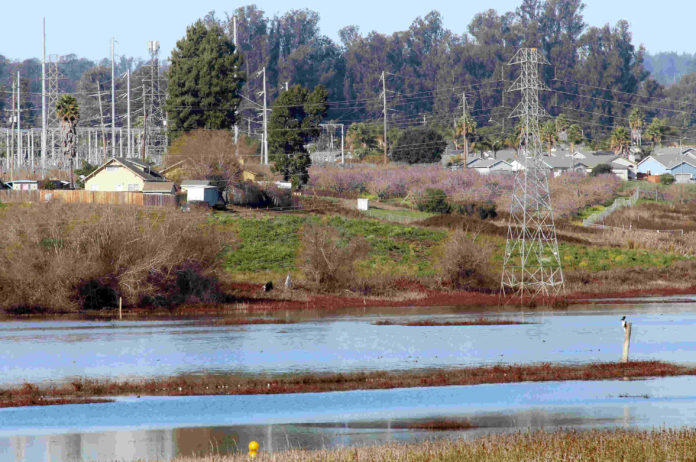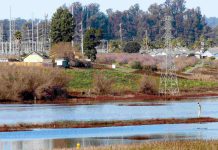
Members of the community continued to push back against the introduction of Battery Energy Storage Systems (BESS) to Santa Cruz County at a community workshop on July 30.
The workshop—which more than 30 people attended–was held by the Santa Cruz County Commission on the Environment as a way of providing the public with “additional expert testimony,” according to a County of Santa Cruz news release.
Slated to speak at the meeting via a Zoom call were Scott Murtishaw, Executive Director of the California Energy Storage Alliance, and Michael Nicholas–an Energy Storage Specialist and Fire Consultant with Hiller Companies.
The California Energy Storage Alliance was founded in 2009. According to their website, CESA’s mission is to “advocate for energy storage as a key resource to achieve a more affordable, efficient, reliable, safe and sustainable electric power system for all Californians.”
Murtishaw said that as of April, California has close to 16,000 megawatts of energy storage. CESA’s goal is to have 52,000 MW stored by 2045.
Much of Murtishaw’s presentation covered emerging energy storage technologies, such as the different types of batteries that BESS facilities can store.
As of now, lithium-ion batteries are widely viewed as the best option for energy storage because of their durability, low cost, high density, and high efficiency.
While Murtishaw did not specifically discuss the battery storage sites that are planned for Santa Cruz county, it has been confirmed that the proposed facility on Minto Road in Watsonville will store lithium-ion batteries.
According to the company behind the project, New Leaf Energy
, lithium-ion batteries are more stable than the widely-used nickel-manganese-cobalt batteries.
The latter type was stored in the Moss Landing facility that erupted in flames last January.
Despite the popularity of lithium-ion batteries, there may be a growing demand for alternative types of energy storage that could be safer.
This summer, China made strides in the energy storage field by creating the first large-scale sodium-ion battery storage facility. Sodium-ion batteries are generally considered more sustainable and safer than lithium-ion batteries, but they don’t have as high of an energy density or as long of a cycle life, experts say.
Santa Cruz County Environmental Commissioner Kris Damhorst, along with other community members, asked about the viability of sodium-ion battery storage in California.
But according to Murtishaw, they “are not being manufactured for grid-scale use yet.”
New Leaf Energy project lead Max Christian says says that sodium-ion products are not currently commercially viable and are therefore not available for use in New Leaf Energy’s proposed project.
“To be commercially viable, a product would need an established track record of years of use in the field and would need to be fully supported by the company through warranty and maintenance services,” Christian said.
One member of the community, John Hasar, suggested the possibility of using flow batteries as an alternative energy source. Hasar said he works for a flow battery manufacturing company.
Flow batteries have their energy stored separately from the battery itself in tanks of liquid electrolytes. The energy from lithium-ion batteries is stored within the battery cell, giving them a higher energy density but also making them more susceptible to fires and thermal runaway.
“I don’t think we should be led to believe that if we don’t have lithium-ion, there is no reliability for the grid. There are other technologies to fill the need,” Hasar said.
But approximately 95% of all BESS facilities do not use FLOW batteries, primarily because they are too slow to react to the real-time needs of the electricity grid to draw power from batteries on an instantaneous basis, according to Christian.
Nicholas attempted to reassure the public that future BESS facilities would be required to meet strict safety regulations and that local fire departments would undergo rigorous training in the case of a fire.
Nicholas said there is a “long-term relationship between BESS operators and fire departments.”
He said that local fire departments will be trained prior to the facilities becoming operational and will also complete annual training. Some of the safety measures include designing fire alarm systems, testing explosion prevention, and conducting large-scale burn tests to assess fire resistance and safety.
However, the presentation did little to comfort members of a community that vividly remembers the Moss Landing Battery Fire.
During that event on Jan. 16, a BESS facility operated by Vistra caught fire, a fire that reignited a month later.
People living in the vicinity reported deleterious health effects from the toxic smoke that emitted from the blaze for days.
The U.S. Environmental Protection Agency has ordered Vistra to clean up the site.
But Christian says the comparison between the Vistra plant and the facility proposed by his company is inaccurate and unfair.
The Vistra plant, he said, involved approximately 100,000 batteries, approximately 80,000 of which are estimated to have burned in the fire.
This was possible because all the batteries were placed together, unseparated and arranged inside an old building.
The BESS facility proposed for Minto Road, Christian said, would have no more than 40 batteries that could possibly catch fire at the same time, thanks to containerization and current safety technology.
“To be clear, we are talking about 100,000 batteries vs. 40 batteries – approximately equivalent to a house fire, in terms of volume of materials burned,” he said.
A handful of people also called attention to an explosion that occurred at a lithium-ion BESS facility in Surprise, Arizona in 2019.
“This is not an isolated, one-off thing that happened in Moss Landing,” said Becky Steinbruner.
“Why [are you] not considering the public health and safety as foremost in this presentation?” Steinbruner said.
Nina Audino said the Moss Landing Fire was a “worst-case scenario,” not an “outlier.”
Audino is a retired teacher and has organized several meetings since April to rally the community against the county’s planned BESS sites.
Christian says the incidents cited are not parallel to what is proposed by New Leaf Energy on Minto Road.
According to Christian, the Surprise incident involved a single container that exploded when firefighters attempted to enter the container. There was no spread to adjacent containers.
Also, the battery was of the NMC chemistry, not the safer LFP chemistry that is now standard.
Christian says that the incident inspired a number of safety upgrades, including response plans for first responders and a reformatting of containers to make it so that people no longer enter the container, but rather access batteries through cabinet doors that line the exterior of the container.
Moreover, the Netherlands incident did not involve more than one container; there was no propagation from one container to another, he says.
Christian added that New Leaf has worked with local CalFire representatives such as Watsonville City Fire Department and North County Fire Protection District.
In addition, he said, there is no proven data available to indicate any loss of property value that has resulted from the existence of a battery storage facility.
The incident at Moss Landing was truly awful, never should have happened and never will again, thanks to current safety and planning codes,” Christian said.
•••
This story has been updated, the project on Minto Road is called New Leaf Energy, not Seahawk.













This is another example of Santa Cruz County using South County as their trash can and experiment center. Why not Aptos, or Soquel, Westside? This is where most of energy use is anyway? I object to any fire hazard being put in our agricultural areas, our food sources are too important. The storage plants have caused massive harm. Where are the testing results from Santa Cruz County showing no pollutants from the Moss Landing fire got into our fruit and vegetables? Right!
I appreciate the article. However, it failed to explain why new technology is safer than old technology. What, for example, is LFP? Is it different from what was used in Moss Landing? How and why is it different? Why did the article not mention this distinction?
I like our current energy storage facility- Los Banos Reservoir!
When there is excess energy, water is pumped up from the forebay inot the reservoir.
When energy is needed, water is released thru the hrdroelectic generators.
Not to mention the lake providing recreational enjoyment for the locals!!
Safe and fun! No depedence on China, environmental damage from the lithium mining and labor exploitation!